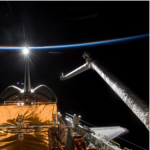
Space Shuttle First Flights: An Era Ends, A New Age Begins
Space Shuttle is ended. The future of near-earth manned spaceflight is now in the hands of private industry. As I believe it should be.

Space Shuttle is ended. The future of near-earth manned spaceflight is now in the hands of private industry. As I believe it should be.

Guest blogger veteran Shuttle astronaut Mike Mullane weighs in on the severe impact damage to Atlantis on his own 1988 flight (STS-27) and to Columbia’s disastrous flight in 2003 (STS-107)

As with Apollo 13, NASA “can do amazing things when they’ve got their back against the wall”. But for Space Shuttle Columbia they didn’t try.

Richard Feynman’s question about Space Shuttle Challenger was, “What is the cause of management’s fantastic faith in the machinery?”

On the eve of the Space Shuttle Challenger launch the Morton Thiokol engineering team protested the decision to launch. They were overridden by NASA

The maiden voyage of Space Shuttle Discovery was scheduled for June 25, 1984. The first-ever main engine shutdown launch abort scared the crap out of us.

Mike Mullane offered me a personal memento from Judy from their first Space Shuttle flight. I still have it.

Shuttle astronaut Judy Resnik was a pilot, a classical pianist, and had a PhD in Electrical Engineering. And she was a terrific emissary for NASA, as I found out when I invited her to speak to the IBM Shuttle Software team.

Astronaut Mike Mullane knew Shuttle was an experimental spaceship sitting atop highly volatile explosives. When NASA allowed civilians to ride they were implying it was safe when it was not. Unfortunately, he was right.

Our Shuttle flight software team had the “distinction” of hearing Walter Cronkite describe, live and on national television, whether we’d done our work correctly.

I had visions of the Space Shuttle Enterprise getting jostled during separation and colliding with the 747’s vertical stabilizer – which would definitely make for a bad day all around.

NASA’s John Aaron set high standards for IBM, and Space Shuttle onboard software came closer to “error-free” than any large, complex software ever built.

I met with John Aaron to explain why IBM couldn’t fulfill a Shuttle software contract that required zero errors. His answer changed my mind.

NASA required IBM’s Space Shuttle software to be delivered “error-free”. It doesn’t take a rocket scientist to understand the likelihood of that was extremely low.

During the Apollo Program, NASA’s Phil Shaffer had subjected me to what I’d describe today as a version of “Shark Tank”. I wasn’t looking forward to presenting to him again on Shuttle.

The first version of the Shuttle flight software had two serious problems: it couldn’t fit in the computer, and it ran way too slow. IBM was two years into the contract and basically nothing worked. All hell broke loose.

Hearing about the near-legendary competence of NASA astronauts was one thing, seeing it in action was humbling. Bob Crippen and Dick Truly, the two I got to work with on Space Shuttle, were the most impressive professionals I’ve met.

By comparison to the Space Shuttle, Apollo was a Model-T Ford – no set of computer-controlled spaceship operations like this had ever been attempted. Nothing that got us to the Moon could be reused here, and so it was discarded.

During high speed atmospheric flight, the extreme forces buffeting the Space Shuttle produced abrupt, violent oscillations that, left unattended, would cause it to spiral out of control. No human was capable of flying the Shuttle unassisted.

The Space Shuttle’s onboard computer system alone weighed more than the entire Apollo Command Module.

An Air Force requirement demanded wings for the Space Shuttle, and that drove everything else about its design. Yet they were never used for that purpose.

In spite of having four separate sets of rocket engines, for the entire flight through the atmosphere and landing, the Shuttle Orbiter was simply an unpowered glider.

The Space Shuttle was immensely different and more complex, in both concept and design, from anything attempted on Apollo.

In 1959, U.S. astronauts piloted an airplane-shaped rocket ship into space, and then flew nearly 200 missions, twenty years before the first Space Shuttle ever left the ground.

The Space Shuttle launch site could have been Cape Hatteras, North Carolina

Now that the era of Space Shuttle has passed, was it all worth it? While the Apollo Program was the great adventure of our age, what exactly did this stepchild do to earn its keep?
Notifications

Recent Comments